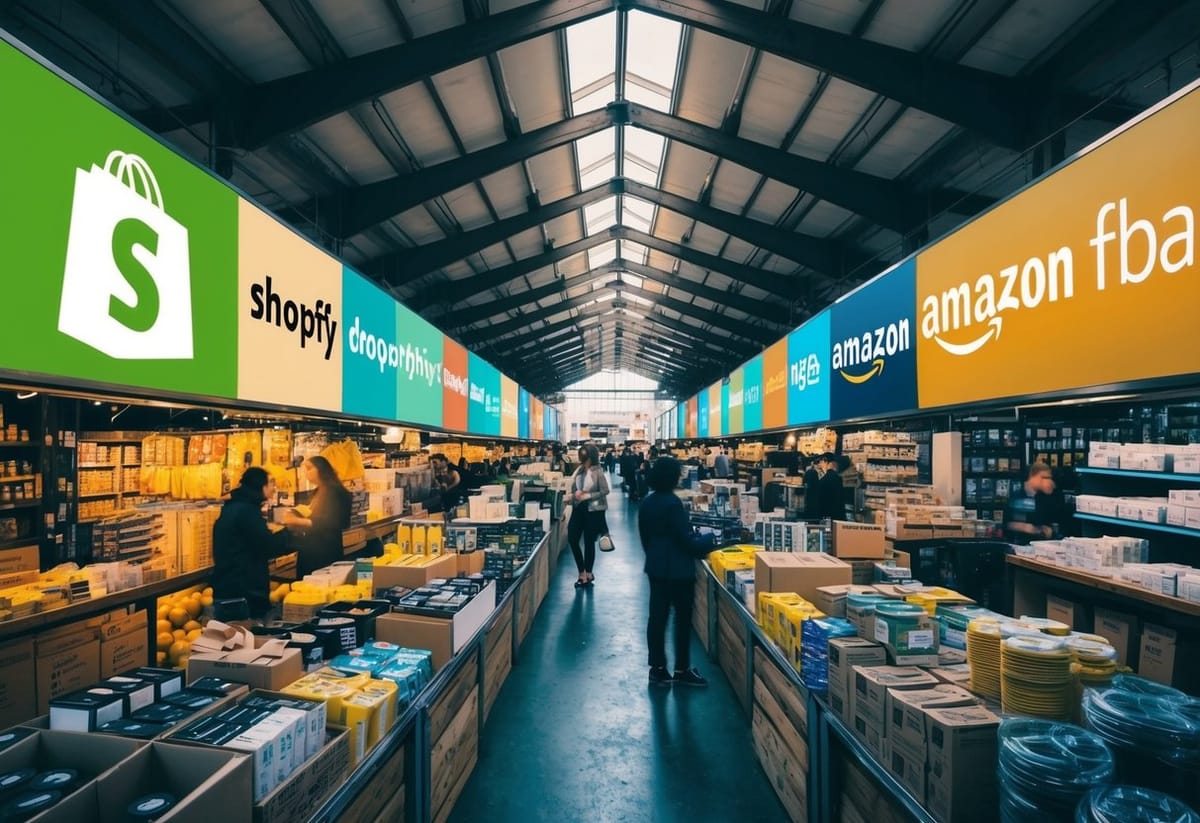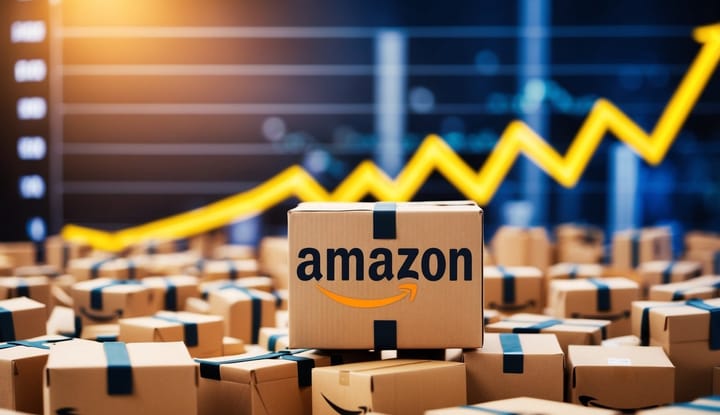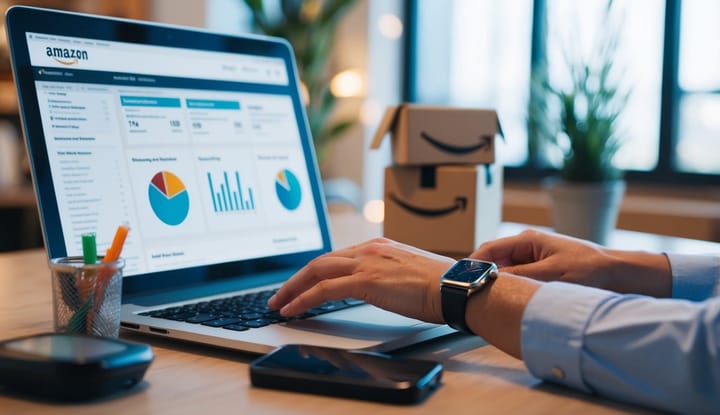Shopify Dropshipping vs Amazon FBA: Choosing the Best Model

Starting an online business can be exciting, but choosing the right platform is crucial. Shopify dropshipping and Amazon FBA are two popular options for e-commerce entrepreneurs. Both have their strengths and weaknesses.
Shopify dropshipping lets you sell products without holding inventory. You set up an online store and partner with suppliers who ship items directly to customers. Amazon FBA (Fulfillment by Amazon) requires you to buy inventory upfront, but Amazon handles storage, packing, and shipping. This takes care of many logistics headaches.
Each model has different costs, control levels, and growth potential. Shopify gives you more freedom to build your brand, while Amazon offers a built-in customer base. The best choice depends on your goals, budget, and preferred business style.
Key Takeaways
- Shopify dropshipping needs less upfront investment but Amazon FBA provides more fulfillment support
- Brand control is greater with Shopify while Amazon offers a larger existing customer base
- Both models have unique fee structures that impact profit margins
Understanding Dropshipping and Amazon FBA
Dropshipping and Amazon FBA are two popular ways to sell products online. They have key differences in how inventory and shipping are handled. Each method has its own pros and cons for sellers.
Defining Dropshipping and Amazon FBA
Dropshipping lets sellers list products without holding inventory. When a customer orders, the seller buys the item from a supplier who ships it directly to the buyer. The seller never handles the product.
Amazon FBA (Fulfillment by Amazon) is different. Sellers send their products to Amazon warehouses. Amazon stores the items and handles shipping when orders come in. They also take care of customer service and returns.
Both methods aim to make selling easier, but work in very different ways.
Key Differences Between Shopify Dropshipping and Amazon FBA
Shopify dropshipping gives sellers more control over their brand. They can design their own website and choose which products to sell. But they must find reliable suppliers and manage customer service themselves.
Amazon FBA offers a built-in customer base and handles logistics. This saves time but comes with fees and less control over branding. Sellers must follow Amazon's rules and compete with many other sellers.
Dropshipping has lower startup costs. FBA requires buying inventory upfront.
The Ecommerce Landscape
Online shopping keeps growing. More people buy things on the internet each year. This growth creates chances for new sellers to enter the market.
Big marketplaces like Amazon attract many shoppers. But niche stores can also do well by targeting specific customers.
Mobile shopping is becoming more common. Sellers need to make sure their stores work well on phones and tablets.
Social media plays a big role in online sales. Many people find products through apps like Instagram and TikTok.
Setting Up Your Business
Starting an online business involves key setup steps. The process differs between Shopify dropshipping and Amazon FBA, each with its own requirements and considerations.
Starting With Shopify Dropshipping
To begin Shopify dropshipping, sign up for a Shopify account. Choose a store name and pick a theme for your site.
Next, find suppliers and add products to your store. Many use apps like Oberlo to connect with suppliers and import items.
Set up payment methods and shipping rates. Shopify offers various options to fit different business needs.
Create essential pages like "About Us" and "Contact". These help build trust with customers.
Finally, launch your store and start marketing. Shopify provides tools to help you reach potential buyers.
Launching an Amazon FBA Business
To start with Amazon FBA, create an Amazon Seller account. Choose between Individual and Professional selling plans based on your goals.
Research products to sell. Look for items with good demand and profit margins.
Source your products from manufacturers or wholesalers. Ensure they meet Amazon's quality standards.
Create product listings with clear titles, descriptions, and high-quality images. Use relevant keywords to improve visibility.
Prepare your inventory for shipment to Amazon's warehouses. Follow their packaging and labeling guidelines carefully.
Ship your products to Amazon. They'll store, pack, and ship items to customers as orders come in.
Costs and Fees
Shopify and Amazon FBA have different pricing structures and fees that impact seller profits. Understanding these costs helps businesses choose the right platform.
Understanding Shopify Pricing and Fees
Shopify offers three main pricing tiers: Basic, Shopify, and Advanced. The Basic plan starts at $29 per month. Higher tiers cost $79 and $299 monthly. These plans include website hosting and tools to run an online store.
Shopify charges transaction fees for each sale. These range from 2.9% + $0.30 to 2.4% + $0.30, depending on the plan. Using Shopify Payments can eliminate these fees.
For dropshipping, Shopify has no extra storage or fulfillment costs. Sellers pay their suppliers directly for products and shipping.
Amazon Seller Costs and FBA Fees
Amazon's fee structure is more complex. Sellers pay $39.99 monthly for a Professional account. Individual sellers can pay $0.99 per item sold instead.
FBA fees include:
- Fulfillment fees: $2.50 to $5.40+ per unit
- Storage fees: $0.75 to $2.40 per cubic foot monthly
- Referral fees: 8% to 45% of the item price
FBA handles storage, packing, and shipping. This service adds costs but saves time for sellers.
Amazon's fees can eat into profits, especially for low-priced items. Sellers must factor these costs into their pricing strategy.
Inventory Management and Fulfillment

Dropshipping and Amazon FBA use different approaches to handle product storage and order processing. These methods impact how sellers manage inventory and fulfill customer orders.
Dropshipping: A Just-In-Time Approach
Dropshipping eliminates the need for sellers to keep inventory on hand. When a customer places an order, the seller passes it to their supplier. The supplier then ships the product directly to the customer.
This method reduces upfront costs and storage needs. Sellers don't have to buy products in bulk or pay for warehouse space. It also allows for a wider product range without increased inventory costs.
But dropshipping has some drawbacks. Sellers have less control over product quality and shipping times. They also can't add custom packaging or inserts to orders.
Amazon FBA: Stock and Store
Amazon FBA requires sellers to send their products to Amazon's warehouses. Amazon then stores these items and handles order fulfillment when customers buy them.
This system offers fast shipping and reliable order processing. Amazon's large network of fulfillment centers enables quick delivery across many locations. FBA also includes customer service and returns handling.
Sellers using FBA need to manage their inventory levels carefully. They must balance having enough stock to meet demand without overpaying for storage. Amazon charges fees for long-term storage of slow-moving items.
FBA gives sellers more control over product quality. They can inspect items before sending them to Amazon. It also allows for custom packaging and inserts.
Marketing and Customer Acquisition

Marketing plays a key role in both Shopify dropshipping and Amazon FBA. Each platform offers different ways to reach customers and grow sales.
Shopify Dropshipping Marketing Techniques
Shopify gives store owners full control over their marketing. They can use SEO to improve their site's visibility in search results. This helps bring in organic traffic.
Social media marketing is another powerful tool. Store owners can create profiles on platforms like Instagram and Facebook to showcase products and engage with customers.
PPC ads on Google and social media can drive targeted traffic to Shopify stores. These paid campaigns can be adjusted based on performance and budget.
Email marketing lets Shopify sellers build a direct relationship with customers. They can send newsletters, promotions, and product updates to their mailing list.
Amazon FBA and Marketplace Visibility
Amazon FBA sellers benefit from the platform's huge customer base. Millions of people already shop on Amazon, giving products built-in visibility.
Optimizing product listings with relevant keywords helps improve search rankings within Amazon. This can boost organic sales without extra marketing costs.
Amazon offers its own PPC advertising system called Sponsored Products. Sellers can create ads that appear in search results and on product pages.
Brand Registry allows FBA sellers to create a stronger brand presence on Amazon. This includes features like A+ Content and Sponsored Brands ads.
Amazon's recommendation algorithm can suggest products to shoppers based on their browsing and purchase history. This can lead to more sales for FBA sellers.
Maximizing Sales and Profitability

Boosting profits requires smart pricing and trend analysis. These strategies can help sellers on both Shopify and Amazon FBA increase their bottom line.
Pricing Strategies for Higher Profits
Setting the right price is key for e-commerce success. Start by checking competitor prices. Then, factor in your costs and desired profit margin. Consider using dynamic pricing to adjust based on demand.
Try offering bundles or bulk discounts to increase order values. This can boost your average sale amount. Test different price points to find what works best for each product.
For Shopify stores, create pricing tiers or membership plans. This can lead to more repeat customers. On Amazon, use their pricing tools to stay competitive while protecting profits.
Analyzing and Leveraging Sales Trends
Keep a close eye on which products sell best. Look at daily, weekly, and seasonal patterns. Use this data to guide inventory choices and marketing efforts.
Track conversion rates for different items and categories. Improve product pages that underperform. For Shopify, use apps to show real-time sales trends. On Amazon, their analytics can reveal top-selling items in each niche.
Pay attention to broader market trends too. Stay up-to-date on popular products in your industry. This helps you stock items customers want before they know they want them.
Customer Service and Support

Customer service plays a big role in e-commerce success. Both Shopify and Amazon FBA offer support, but in different ways.
Shopify's Customer-Centric Model
Shopify gives store owners tools to handle customer service themselves. They provide a help center and email support for sellers.
Shopify lets you add live chat and FAQ sections to your store. This helps answer customer questions quickly.
Store owners can also use apps to manage returns and refunds. Shopify's system tracks orders and customer info in one place.
The platform offers 24/7 support for store owners by phone, email, and chat. This helps solve technical issues fast.
Amazon's Customer Support and Seller Services
Amazon FBA takes care of most customer service tasks for sellers. They handle returns, refunds, and customer questions.
This saves sellers time and effort. It also means less control over customer interactions.
Amazon's customer service team is available 24/7 by phone and email. They speak many languages to help global customers.
FBA sellers can use Seller Central to track orders and resolve issues. Amazon also provides account health tools and selling coach tips.
Prime members get fast shipping and easy returns. This builds customer trust in FBA products.
Platform Features and Customization
Shopify and Amazon FBA offer different tools for building online stores. Each platform has unique features that shape how sellers run their businesses.
Exploring Shopify's Customization Capabilities
Shopify gives sellers lots of control over their online stores. Users can pick from many themes to set up their shop's look. These themes can be changed to match a brand's style.
Shopify's App Store adds more options. It has tools for things like:
- Marketing
- Inventory tracking
- Customer service
Sellers can add these apps to make their stores work better. This helps create a unique shopping experience for customers.
Utilizing Amazon Marketplace Features
Amazon FBA focuses on selling through its big marketplace. Sellers use Amazon's system, which many shoppers know and trust.
Key Amazon features include:
- Product listing tools
- Inventory management
- Shipping and returns handled by Amazon
Sellers can use Amazon's search and product ranking systems. This helps products get seen by more people. Amazon also offers tools to track sales and manage customer feedback.
While less customizable than Shopify, Amazon's platform is set up to help sellers reach a wide audience quickly.
Scaling Your Business
Growing an online business takes strategy and effort. Both Shopify dropshipping and Amazon FBA offer ways to expand, but their approaches differ.
Growth Strategies for Shopify Stores
Shopify stores can scale by adding new products and suppliers. Store owners have full control over their brand and marketing. They can run ads, build email lists, and optimize for search engines.
Global expansion is possible by setting up international shipping. Shopify makes it easy to accept various currencies and languages. This helps reach customers worldwide.
Many Shopify sellers start small and grow over time. They can test new product ideas quickly without big upfront costs. As sales increase, they may switch to holding inventory for better profits.
Expanding Your Reach with Amazon FBA
Amazon FBA allows rapid scaling through its huge customer base. Sellers can list products and tap into Amazon's trust and traffic. This often leads to faster initial sales growth.
FBA handles storage and shipping as orders increase. This frees up time for product sourcing and marketing. Sellers can focus on finding winning items and improving listings.
Amazon's global marketplaces offer built-in expansion options. Sellers can list products in multiple countries with relative ease. Prime shipping can boost sales in new markets.
FBA may limit brand control but can drive higher profits through efficient fulfillment. As businesses grow, some sellers mix FBA with their own warehouses for flexibility.
Risks and Considerations
Starting an online business comes with potential pitfalls. Both Shopify dropshipping and Amazon FBA have unique challenges that sellers should know about before diving in.
Potential Downsides of Shopify Dropshipping
Dropshipping on Shopify can lead to lower profit margins. Products often cost more from suppliers, leaving less room for markup. This can make it hard to offer competitive prices.
Finding good suppliers is tough. Bad ones may ship late or send poor quality items. This hurts customer trust and can damage a store's reputation.
Cash flow issues can arise. Shopify charges monthly fees even if you don't make sales. You also pay for ads and web design upfront before seeing any profit.
Customer service can be tricky. You don't control shipping, so solving problems takes extra work. Refunds and returns may eat into profits if not handled well.
Amazon FBA Risks and Complications
Amazon's rules are strict. Breaking them can get a seller account suspended. This can happen suddenly, cutting off income without warning.
Fees add up fast on Amazon. FBA costs, referral fees, and storage fees can slash profits. During slow seasons, storage fees might even outweigh sales revenue.
Amazon owns the customer relationship. Sellers can't build their own email lists or brand loyalty easily. This makes it hard to grow outside of Amazon.
Competition is fierce. Many sellers offer the same products, leading to price wars. This can push profit margins down to unsustainable levels.
Inventory management is complex. Sending too little stock means lost sales. Too much leads to high storage fees. Getting it right takes skill and constant attention.
Future Outlook and Trends
Online shopping is changing fast. Ecommerce platforms are adding new features to keep up. Sellers need to stay on top of these shifts to succeed.
Evolving Trends in Online Shopping
Mobile shopping is growing. More people buy on phones and tablets. Sellers must make their stores mobile-friendly. This means easy-to-use apps and quick checkout.
Big Data helps sellers understand buyers better. It shows what products people want. Sellers can use this info to pick the right items to sell.
Voice shopping is on the rise. People use smart speakers to order products. Sellers should think about how to make their items easy to find by voice.
Adapting to Changes in Ecommerce Platforms
Shopify and Amazon keep adding new tools. Sellers need to learn these tools to stay ahead. For example, Shopify now offers better ways to reach customers on social media.
AI is becoming more important. It can help with customer service and product suggestions. Sellers who use AI well may see better sales.
Building a brand is key. A strong brand can become a saleable asset. This is easier on Shopify, where sellers have more control over their store's look.
Sellers must keep up with platform rules. Both Shopify and Amazon change their policies often. Staying informed helps avoid problems and keeps sales high.
Frequently Asked Questions
Shopify dropshipping and Amazon FBA have key differences in costs, profits, and suitability for different sellers. These common questions address important factors to consider when choosing between the two e-commerce models.
What are the initial costs associated with starting Shopify dropshipping versus Amazon FBA?
Shopify dropshipping typically has lower upfront costs. Sellers pay for a Shopify subscription and any apps they need. Startup costs can be under $100.
Amazon FBA requires more initial investment. Sellers must buy inventory upfront and pay for shipping to Amazon warehouses. Startup costs often range from $500 to $3000 or more.
Can you achieve higher profitability with dropshipping or Amazon FBA?
Profit potential varies for both models. Dropshipping margins are often 15-20% of the sale price. FBA margins can reach 25-40% for successful products.
FBA may offer higher profits per sale, but also has higher costs. Dropshipping profits can add up with enough sales volume.
What are the key differences between Amazon FBA and dropshipping through Shopify?
Amazon FBA sellers store inventory in Amazon warehouses. Amazon handles shipping and customer service. Sellers compete on the Amazon marketplace.
Shopify dropshippers don't hold inventory. Suppliers ship products directly to customers. Sellers create their own online stores and drive their own traffic.
Which platform is more suitable for beginners, Shopify dropshipping or Amazon FBA?
Shopify dropshipping is often easier for beginners. It has lower startup costs and less risk. Sellers can test products without buying inventory.
Amazon FBA has a steeper learning curve and higher initial costs. But it offers access to Amazon's huge customer base.
How does Shopify dropshipping profitability compare to Amazon FBA in recent times?
Both models can be profitable in 2024. Dropshipping faces more competition but still works with the right products and marketing.
FBA profits have tightened due to rising fees and competition. But established sellers still report good margins on successful items.
How do the business models of Amazon FBA, dropshipping, and affiliate marketing differ?
FBA sellers buy and store inventory. They handle product listings and marketing on Amazon. Profits come from product sales.
Dropshippers don't hold inventory. They market products and process orders. Suppliers handle shipping. Profits are the difference between retail and wholesale prices.
Affiliate marketers promote other companies' products. They earn commissions on sales they refer. They don't handle products or customer service.
Shopify Dropshipping or Amazon FBA—Which One’s Right for You?
Join our mini-course at WAH Academy and get a clear breakdown of both models, so you can choose the best path for your goals.
No hype. Just honest, expert guidance.
Tap below to start the course.



